Museum Folkwang, Essen
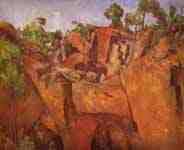
Quarry at Bibémus, Paul Cézanne
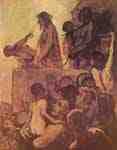
Ecce homo, Honoré Daumier

Woman in front of the setting sun (sunset , sunrise, Woman in the morning sun), Caspar David Friedrich
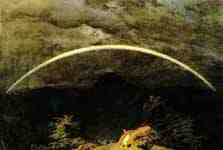
Mountain Landscape with Rainbow, Caspar David Friedrich
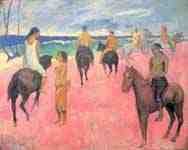 Riders on the beach, Paul Gauguin
Riders on the beach, Paul Gauguin
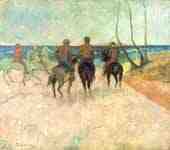
Riders on the beach, Paul Gauguin

Contes barbares (Exotic Sagas), Paul Gauguin
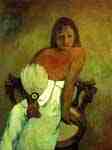 Young Girl with a Fan, Paul Gauguin
Young Girl with a Fan, Paul Gauguin
 Seaweed Collector, Paul Gauguin
Seaweed Collector, Paul Gauguin
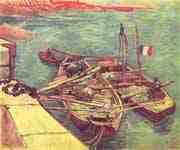
Moored boats with sand, Vincent Willem van Gogh

The newspaper reader, Wilhelm Maria Hubertus Leibl

Travel plans, Adolf Friedrich Erdmann von Menzel

Stairwell lighting at night, Adolf Friedrich Erdmann von Menzel

The painter with Camellia branch (Self-Portrait), Paula Modersohn-Becker
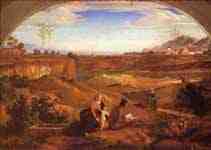
Holy Family with the Infant St. John, Ferdinand Olivier

Man with Parrots, Max Liebermann
Museum Folkwang is a major collection of 19th- and 20th-century art in Essen, Germany. The museum was established in 1922 by merging the Essener Kunstmuseum, which was founded in 1906, and the private Folkwang Museum of the collector and patron Karl Ernst Osthaus in Hagen, founded in 1902.[2]
The term Folkwang derives from the name of the afterlife meadow of the dead, Fólkvangr, presided over by the Norse goddess Freyja.[3]
Museum Folkwang incorporates the Deutsche Plakat Museum (German poster museum), comprising circa 340,000 posters from politics, economy and culture. During a visit in Essen in 1932, Paul J. Sachs called the Folkwang "the most beautiful museum in the world."[4]
In 2007, David Chipperfield designed an extension, which was then built onto the older building.[5][6][7]
Modern art
Portrait of Vincent Nubiola by Joan Miró
Photography
The Photographic Collection was established as an independent department in the Museum Folkwang in 1978; today it contains more than 50,000 photographs and a number of artists’ estates. The Alfried Krupp von Bohlen und Halbach Foundation has been granting fellowships for contemporary German photography since 1982 in cooperation with the Photographic Collection of the Museum Folkwang.
Prints and drawings
German Poster Museum
Antique and Non-European art
History
The Museum Folkwang in the Nazi era
Ernst Gosebruch, director of the museum in the 1920s and 1930s, and earlier directors, had made the museum's collection of modern art into one of the leading collections in the world. However, when the National Socialists came to power in Germany in the early 1930s, they instituted a government-wide purge of what they termed "degenerate art", by which they meant abstract, cubist, expressionist, surrealist and impressionist art. In 1937, Joseph Goebbels created a commission headed by Adolf Ziegler whose mission was to purge all German government-owned museums of such "degenerate" works. The Museum Folkwang fell into the category of government-controlled institutions and was therefore part of the purge. Over 1 200 works of art were removed from the museum (among others by Georges Braque, Paul Cézanne, Giorgio de Chirico, Edmund Cross, André Derain, Henri Matisse, and Edvard Munch), part of over 17 000 works of art removed from museums throughout Germany. The Nazi government first organized a mass exhibition of this "degenerate" art—which, ironically, proved to be quite popular—and then began systematically selling the art to raise cash. Many works of art came into the possession of American and other collectors and museums. In the end, approximately 5 000 works of art deemed unsaleable were burned.[8][9]
The Museum Folkwang and the other museums affected have generally not tried to reclaim these works because at the time, the removal and sale of the works of art were legal under German law. The works of art were ultimately the property of the German government, which had the legal right to dispose of them as it saw fit.[8]
Redesign
A €55m reconstruction was made possible by Berthold Beitz, a philanthropist and former steel baron who initiated his Krupp Foundation to finance the project.[10] An international architectural competition[11] organized by the City of Essen was won by David Chipperfield (against competing designs by David Adjaye, Volker Staab (de), and Zaha Hadid) in March 2007. The new building, adding 16,000 m2 to the existing museum, opened in January 2010, when Essen and the Ruhr Area became European Capital of Culture.
References
800.000 Besucher im Eröffnungsjahr, Museum Folkwang, 15. Februar 2011
"Museum Folkwang, Essen". The Saatchi Gallery. Retrieved 2013-01-17.
"History". Folkwang-uni.de. Retrieved 24 August 2010.
"The Most Beautiful Museum in the World – Museum Folkwang until 1933". Museum Folkwang. 2010. Retrieved 18 October 2015.
"Blog Archive » Museum Folkwang by David Chipperfield". Dezeen. 3 February 2010. Retrieved 24 August 2010.
Woodman, Ellis (19 February 2010). "David Chipperfield’s Museum Folkwang in Essen, Germany | Building Studies | Building Design". Bdonline.co.uk. Retrieved 24 August 2010.
"The new Museum Folkwang: RUHR.2010". Essen-fuer-das-ruhrgebiet.ruhr2010.de. Retrieved 24 August 2010.
"Degenerate Art", Philadelphia Museum of Art, accessed 20 September 2010
"Marc Chagall's Purim", Philadelphia Museum of Art, accessed 20 September 2010
Kate Connolly (January 29, 2010), Folkwang museum unveils Chipperfield redesign The Guardian.
Museum Folkwang in Essen Architectural Competition, retrieved October 2015
----
Fine Art Prints | Greeting Cards | Phone Cases | Lifestyle | Face Masks | Men's , Women' Apparel | Home Decor | jigsaw puzzles | Notebooks | Tapestries | ...
----
Artist
A - B - C - D - E - F - G - H - I - J - K - L - M -
N - O - P - Q - R - S - T - U - V - W - X - Y - Z
Retrieved from "http://en.wikipedia.org/"
All text is available under the terms of the GNU Free Documentation License


